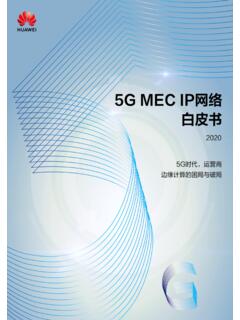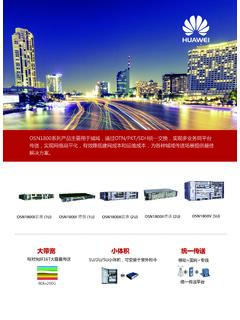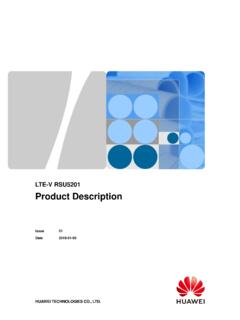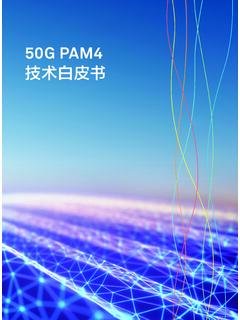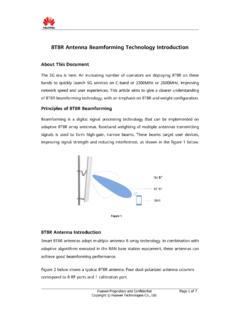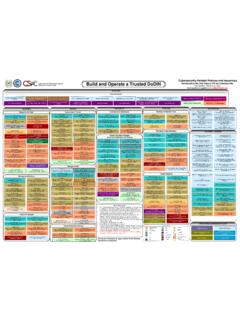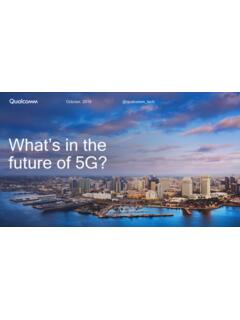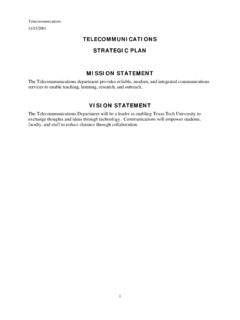Transcription of 5 5G Network Architecture - huawei
1 1 Network Architecture -A High Level View 5G Network Architecture -A High Level View 5G5G Network Architecture5G Network ArchitectureA High-Level Perspective huawei TECHNOLOGIES CO., LTD. Bantian, Longgang DistrictShenzhen518129, P. R. ChinaTel:+86-755-2878080820162 Network Architecture -A High Level View 5G Network Architecture -A High Level View 5 GContentsA Cloud-Native 5G Architecture is Keyto Enabling Diversified Service Requirements 5G Will Enrich the Telecommunication The Driving Force Behind Network Architecture The Service-Driven 5G ArchitectureEnd-to-End Network Slicing for Multiple Industries Based on One Physical Infrastructure Reconstructing the RAN with Multi-Connectivity Is Key to High Speed and MCEC loud-Native New Core Control and User Plane Separation Simplifies the Core Flexible Network Components Satisfy Various Service unified
2 Database ManagementSelf-Service Agile OperationConclusion:Cloud-Native Architecture is the Foundation of 5G Innovation040508091317193 Network Architecture -A High Level View 5G Network Architecture -A High Level View 5 GContentsA Cloud-Native 5G Architecture is Keyto Enabling Diversified Service Requirements 5G Will Enrich the Telecommunication The Driving Force Behind Network Architecture The Service-Driven 5G ArchitectureEnd-to-End Network Slicing for Multiple Industries Based on One Physical Infrastructure Reconstructing the RAN with Multi-Connectivity Is Key to High Speed and MCEC loud-Native New Core Control and User Plane Separation Simplifies the Core Flexible
3 Network Components Satisfy Various Service unified Database ManagementSelf-Service Agile OperationConclusion:Cloud-Native Architecture is the Foundation of 5G Innovation040508091317194 Network Architecture -A High Level View 5G Network Architecture -A High Level View 5GA Cloud-Native 5G Architecture is Key to Enabling Diversified Service RequirementsThrough persistent effort and determination Telecom operators are implementing a digital transformation to create a better digital world. To provide enterprises and individuals with a real time, on demand, all online, DIY, social (ROADS) experience requires an end-to-end (E2E) coordinated Architecture featuring agile, automatic, and intelligent operation during each phase.
4 The comprehensive cloud adaptation of networks, operation systems, and services is a prerequisite for this much anticipated digital transformation. The "All Cloud" strategy is an illuminated exploration into hardware resource pools, Provides logically independent Network slicing on a single Network infrastructure to meet diversified service requirements and provides DC-based cloud Architecture to support various application scenarios. Uses CloudRAN to reconstruct radio access networks (RAN) to provide massive connections of multiple standards and implement on-demand deployment of RAN functions required by 5G.
5 Simplifies core Network Architecture to implement on-demand configuration of Network functions through control and user plane separation, component-based functions, and unified database management. Implements automatic Network slicing service generation, maintenance, and termination for various services to reduce operating expenses through agile Network O& software Architecture , and automatic deployment. Operators transform networks using a Network Architecture based on data center (DC) in which all functions and service applications are running on the cloud DC, referred to as a Cloud-Native the 5G era, a single Network infrastructure can meet diversified service requirements.
6 A Cloud-Native E2E Network Architecture has the following attributes:5 Network Architecture -A High Level View 5G Network Architecture -A High Level View 5G5G Will Enrich the Telecommunication EcosystemIn the new exciting era of 5G, new communication requirements pose challenges on existing networks in terms of technologies and business models. The next-generation mobile Network must meet diversified demands. The International Telecommunication Union (ITU) has classified 5G mobile Network services into three categories: Enhanced Mobile Broadband (eMBB), Ultra-reliable and Low-latency Communications (uRLLC), and Massive Machine Type Communications (mMTC).
7 EMBB aims to meet the people's demand for an increasingly digital lifestyle, and focuses on services that have high requirements for bandwidth, such as high definition (HD) videos, virtual reality (VR), and augmented reality (AR). uRLLC aims to meet expectations for the demanding digital industry and focuses on latency-sensitive services, such as assisted and automated driving, and remote management. mMTC aims to meet demands for a further developed digital society and focuses on services that include high requirements for connection density, such as smart city and smart agriculture.
8 The expansion of service scope for mobile networks enriches the telecom Network ecosystem. A number of traditional industries, such as automotive, healthcare, energy, and municipal systems participate in the construction of this ecosystem. 5G is the beginning of the promotion of digitalization from personal entertainment to society interconnection. Digitalization creates tremendous opportunities for the mobile communication industry but poses strict challenges towards mobile communication Machine Type CommunicationsuRLLCU ltra-reliable and Low-latency CommunicationsFutu re IMT10 GbpseMBBE nhanced Mobile Broadband3D Video, UHD Scr eenWork and play in the cl oudAugmented realityIndust ry automationMission cr itica lapplica tionsSelf drivi ng ca rSmart Home/BuildingSmart CityITU-R WP5D1million/km21ms6 Network Architecture -A High Level View 5G Network Architecture -A High Level View 5GA.
9 The Driving Force Behind Network Architecture TransformationThe existing mobile Network Architecture was designed to meet requirements for voice and conventional MBB services. However, this previous organization has proven to be insufficiently flexible to support diversified 5G services due to multiple 3 GPP version upgrades, a large number of NEs, complex interfaces. The driving force behind the Network Architecture transformation includes the following aspects: Complex networks incorporating multiple services, standards, and site types5G networks must be able to provide diversified services of different KPIs, support co-existent accesses of multiple standards (5G, LTE, and Wi-Fi), and coordinate different site types (macro, micro, and pico base stations).
10 The design challenge to create a Network Architecture capable of supporting such flexibility whilst meeting differentiated access demands is a brave endeavor to satisfy. Coordination of multi-connectivity technologies5G is expected to co-exist with LTE and Wi-Fi for an extended period of time incorporating multi-connectivity technologies and the new 5G air interface. Multi-connectivity technologies must be coordinated based on traffic and mobility requirements of user equipment to provide sufficient transmission throughput and mobile continuity. On-demand deployment of service anchors5G Network Architecture will be designed based on access sites and three-layer DCs.

